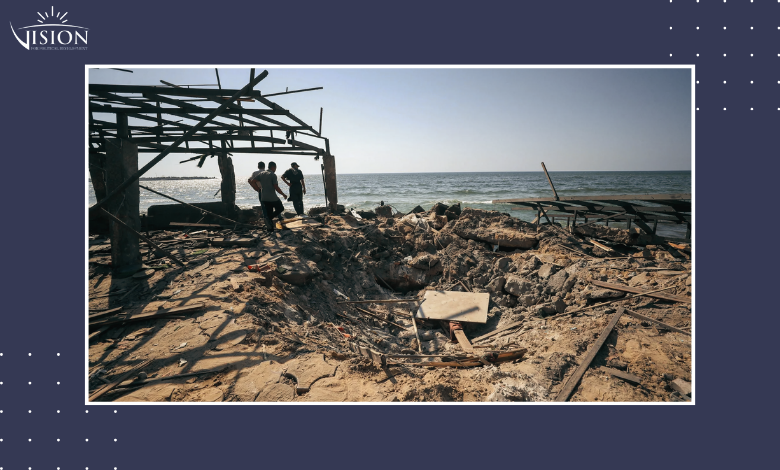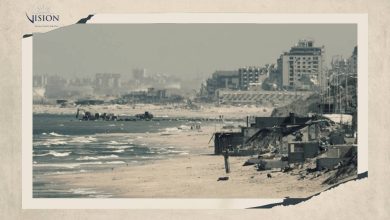In Times of Genocide: Freelancers in Gaza Struggle to Survive

Prior to the ongoing genocide that has continued for 23 months, Palestinian youth in the Gaza Strip were already suffering from high unemployment rates due to the blockade imposed on the territory since 2006. This forced many to seek work outside the Strip, often through online freelancing platforms, which became a primary source of income for a large number of graduates unable to find opportunities in either public or private institutions within Gaza. According to the United Nations, around 12,000 workers in Gaza rely on freelancing over the internet to earn their livelihood.
With the outbreak of the genocidal war on the Strip on October 7, 2023, most freelancers found themselves unable to carry out their tasks or deliver projects on time after Israel’s military destroyed much of the infrastructure, cutting off essential services such as electricity, telecommunications, and internet access. This was compounded by the psychological toll inflicted on workers themselves as a result of relentless bombardment and repeated displacement.
Despite these obstacles, a significant number of freelancers in various fields in Gaza refused to succumb to the harsh reality. Instead, they sought out alternatives to continue their work and recover their source of livelihood, particularly amid the dire conditions created by the war; marked by catastrophic famine, acute shortages of food and basic resources, scarcity of cash, and the rise of takyeesh (cash withdrawals of remittances).
This report seeks to shed light on the major crises and challenges faced by freelancers in the Gaza Strip since the outbreak of the genocidal war on October 7, 2023, as follows:
First: Near-total loss of electricity
From the very first day of the Gaza genocide, the Israeli occupation cut off all sources of energy supplying the Strip and blocked the entry of fuel. This forced Gaza’s only power plant to cease operations. The Israeli military also attacked and completely destroyed the core infrastructure of the electricity and energy system, casting a heavy shadow over digital work and rendering freelancing nearly impossible.
Telecommunication towers, internet routers, and the digital devices upon which freelancers in Gaza rely depend almost entirely on electricity. Its absence has paralyzed their ability to work, reduced productivity, and undermined their chances of success, as they became increasingly unable to deliver projects on time. Although some tried to resort to alternatives such as subscribing to generator services, using UPS batteries, or purchasing solar panels; these options imposed additional burdens. They were limited, extremely costly, and affordable only to higher-income individuals. In some cases, freelancers spent nearly all of their earnings just to cover generator subscriptions or solar panel installments.
Many freelancers sought out places where electricity was available, such as cafés or co-working spaces, often walking long distances to reach them, only to find electricity and internet provided for just a few hours—insufficient for completing their tasks. Architect Ahmed Abdullah, who specializes in interior design, explained how he spends more than three hours each morning preparing breakfast over an open fire before traveling to a workspace with power and internet access. This reduces his actual working hours, limiting his productivity and his ability to take on multiple projects to improve his skills and income.
Others resorted to using public charging stations scattered across Gaza to charge their laptops, then working offline until the battery drained completely. This not only reduced their productivity but also risked damaging their devices, threatening the loss of their only source of livelihood[1].
Another persistent problem freelancers faced regarding electricity was its sudden outage, which led to data loss or corruption of unsaved files. Noha Saad, a UX/UI designer, described how she lost hours of work on the design platform Figma due to a sudden blackout, forcing her to redo all her modifications from scratch[2].
Second: The Collapse of Telecommunications and Internet Services
Since the beginning of the genocide war, the occupation forces have completely destroyed more than 50% of the telecommunications infrastructure in the Gaza Strip and partially damaged 25% of what remained. This resulted in months-long communication blackouts during which Palestinians in Gaza lived in total isolation. Although international organizations intervened and coordinated with the Israeli occupation army to allow maintenance crews from the Palestinian Telecommunications Company safe passage, occupation forces repeatedly targeted them, killing several and injuring others.
The destruction of cellular towers and the internet infrastructure paralyzed digital services, preventing freelancers from communicating with clients abroad and on global platforms, cutting them off from their main source of income. This was the case for Noha Saad, whose work relied heavily on the internet and regular communication with international clients via email and freelancing platforms—a task that became nearly impossible under recurring electricity and internet outages[3].
Despite these enormous challenges imposed by the occupation through cutting off communications and internet networks, Palestinian youth sought alternatives. They resorted to using satellite internet SIMs, also known as e-SIMs, which work on advanced smart devices and require being in high or open areas to function properly.
The author of this report recounts a bitter experience, having had to walk very long distances from her residential area just to access one of these SIM connections, which became a source of income for their holders. However, these SIMs are extremely slow, making it very difficult to upload materials online.
During the announced ceasefire periods between the Israeli occupation and Hamas, some cafés and private institutions opened workspaces designed to provide a comfortable and organized environment for workers. These included co-working spaces and private offices equipped with continuous power supply and fast, stable internet to ensure work continuity and uninterrupted global communication.
This gave remote-working youth a bleak hope to return to professional life and confront the hardships of survival imposed by the genocide war; despite the deliberate restrictions and cuts periodically enforced by the Israeli occupation on service providers. These interruptions completely halted work and made it impossible to receive funds through platforms such as PayPal, Payoneer, or bank transfers. Even when funds were sent, freelancers in Gaza were unable to confirm or manage their transfers.
Third: Damage to Equipment
The suffering of freelancers in Gaza did not end with the electricity and internet blackouts. It extended to the loss and destruction of their devices as a result of the occupation targeting their homes. Since the start of the genocide war on October 7, 2023, the occupation has imposed a suffocating blockade preventing the entry of essential life supplies into Gaza, including electronic devices such as computers, mobile phones, audio recorders, and photography equipment. This crippled digital work and caused the collapse of the digital infrastructure, creating a catastrophic reality for remote workers in fields such as programming, design, translation, marketing, and online research.
According to voice-over artist Soha Sukkar, the genocide war deprived her of her essential work tools, including her microphone, soundproof studio, and computer used for audio editing and production. This forced her to stop working for nearly a year and a half[4].
Fourth: Loss of the Sole Source of Income
Freelancers in Gaza faced a major crisis during the first months of the genocide, as they lost their primary source of income and international work contracts. This happened because they were unable to meet project deadlines, leading some platforms to automatically suspend their accounts due to forced absence or delays—without any consideration of the wartime conditions.
Voice-over artist Soha Sukkar explains that she lost her work for nearly a year and a half after her equipment was buried under the rubble of her home destroyed by the Israeli occupation. Her contracts were cancelled, her ratings dropped, and her account was marked as inactive[5].
Meanwhile, Ahmed Abdullah recounts that after being cut off from work for two months, he was eventually able to reconnect with his clients. However, he was shocked by their response:
“Only 20% of the clients I used to work with answered my calls, and just 10% agreed to resume work. The rest refused, citing the fact that I live in an unsafe area marked by war and constant conflict. I suddenly found myself having lost nearly 90% of my work, struggling hard to hold on to the remaining 10% by not telling them about the bombings, targeting, and repeated displacement around me—fearing that if I did, I would lose them too and be left with no source of income.”[6].
Fifth: Intensified Psychological Pressures
Freelancers in Gaza suffer from severe psychological stress due to ongoing security and economic crises, coupled with an unstable work environment. The destructive war has cost many of them their families or loved ones, while others have lost their work tools and are unable to replace them; forcing them out of work despite their competence and creativity.
Beyond the pain of loss, destruction, and repeated displacement, many freelancers have shown resilience, facing the genocidal onslaught with persistence and determination to stay connected with clients and freelance platforms. Yet, fear and concern for their families make concentration on work nearly impossible. The constant anxiety about displacement and the reluctance of clients to engage with workers in unsafe environments generate continuous mental strain, undermining both mental health and motivation to continue.
As Ahmed Abdullah recounts, on one occasion he was forced to walk five kilometers on foot just to reach a satellite internet signal and inform a client that his project was still in progress and had not stopped—fearing that if he mentioned the realities of war, he might lose that client altogether[7].
Sixth: Difficulty in Receiving Payments
One of the most pressing challenges brought about by the genocide in Gaza has been the severe disruption of financial transactions, which has deepened the struggles of freelancers. The closure of Palestinian banks and the shutdown of ATMs in Gaza halted the normal flow of money, creating a liquidity crisis that left only existing cash in circulation, with no new currency injected into local markets. As a result, many citizens, including freelancers reliant on international payments, were forced to depend on the informal exchange market to withdraw remittances, a practice known locally as “takyeesh” (cashing out). This process often came with exorbitant fees, at times consuming half or more of the original payment, drastically reducing its intended value.
Compounding the crisis was a new dilemma: many vendors refused to accept worn-out or older currency notes, further limiting the usability of cash. As freelancer Noha Saad explains, this reality turned her income into a mere survival tool rather than a means to live with dignity. She recounts working tirelessly, only to see nearly half of her payment swallowed by money exchangers’ commissions, and an additional portion lost when trying to circulate old notes—sometimes costing her $20 per banknote. What little remained was quickly absorbed by the rising cost of daily survival under siege conditions[8].
This is echoed by engineer Ahmed Abdullah, who explains that nearly 15–16% of his earnings go to the company that receives the payment from the client and transfers it to his account in the Bank of Palestine. An additional 35–50% is lost to “takyeesh” (cashing out) fees, while workspace rent consumes 10–15%, and costly transportation takes up around 7%. After all these deductions, less than 40% of the amount remains, which buys him goods worth barely 5% of their pre-war market value due to soaring food prices[9].
Conclusion
The genocide in the Gaza Strip, now approaching two years, the loss of electricity, communications, and internet has not only severed Palestinians from the outside world but also strangled and dismantled one of their vital pillars: the youth of Gaza. For them, online freelance work once represented a rare gateway to freedom and economic security in a besieged land where their lives have been constrained since childhood.
The Israeli occupation destroyed Gaza’s power infrastructure, severed supply lines from the occupied territories, and blocked the fuel needed to operate the enclave’s only power plant. This, in turn, crippled what remained of communication towers and internet networks, much of which was also bombed, erasing opportunities for freelancers and crushing their aspirations for self-development.
Yet, despite all these obstacles, Gaza’s youth continue to search; for work, for hope, and for life; defying the brutal genocide and the suffocating blockade imposed on them for nearly two decades.
[1] Interview conducted by the researcher with graphic designer Rawa Samour on 8 August 2025.
[2] Interview conducted by the researcher with designer Noha Saad on 14 August 2025.
[3] Interview with Noha Saad (previous source).
[4] Interview conducted by the researcher with audio commentator Suha Sukkar on 12 August 2025.
[5] Interview with Suha Sukkar (previous source).
[6] Interview with Ahmed Abdullah (previous source).
[7] Interview with Ahmed Abdullah (previous source).
[8] Interview with Noha Saad (previous source).
[9] Interview with Ahmed Abdullah (previous source).
NOTE: This text is adabted from original Arabic article.





